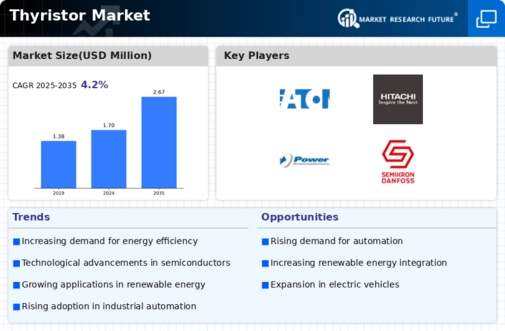Market Share
Thyristor Market Share Analysis
In the Thyristor market, the strategic positioning of market share is a critical aspect that manufacturers carefully navigate to gain a competitive edge. One prevalent strategy is differentiation, wherein companies focus on creating unique features or functionalities in their thyristors that set them apart from competitors. This can include innovations in design, performance, or energy efficiency. By offering distinctive products, companies aim to capture a specific segment of the market and build a loyal customer base.
Price positioning is another key strategy in the Thyristor market. Some manufacturers opt for a cost leadership approach, aiming to provide thyristors at a lower price point compared to competitors. This strategy is often employed to target price-sensitive markets or gain a competitive advantage based on affordability. On the flip side, premium pricing strategies involve positioning thyristors as high-quality, premium products, and targeting customers willing to pay a premium for advanced features or superior performance.
Market segmentation is a strategy that involves targeting specific customer segments based on their unique needs and preferences. Thyristor manufacturers may develop products tailored to the requirements of distinct industries or applications, such as automotive, renewable energy, or telecommunications. By understanding the diverse needs of different market segments, companies can position their thyristors strategically to maximize market share within those niches.
Geographic positioning is crucial for companies operating in the global Thyristor market. Manufacturers may choose to focus on specific regions or countries where there is a high demand for electronic components. Factors such as regulatory compliance, infrastructure development, and economic conditions in different regions influence the decision to concentrate efforts in specific geographic areas. This targeted approach allows companies to establish a strong presence in key markets and optimize their market share.
Collaborative strategies, such as partnerships and alliances, are increasingly common in the Thyristor market. Companies may collaborate with other players in the supply chain, such as semiconductor manufacturers or technology integrators, to enhance their overall market position. These collaborations can lead to the development of integrated solutions or bundled offerings, providing added value to customers and creating a competitive advantage.
Strategic acquisitions are employed by some companies to strengthen their market share position in the Thyristor market. Acquiring or merging with other firms allows companies to expand their product portfolio, access new technologies, and broaden their customer base. This strategy enables them to consolidate their position and gain a competitive advantage over rivals.
Brand positioning is integral to market share strategies in the Thyristor market. Building a strong brand image through effective marketing, communication, and customer relations helps manufacturers establish trust and credibility. A positive brand perception can influence purchasing decisions, leading to increased market share as customers prefer products from reputable and trusted brands.
Continuous innovation is a fundamental strategy for maintaining and expanding market share in the Thyristor market. Companies invest in research and development to stay ahead of technological advancements, introducing new and improved thyristors to the market. This innovation-driven approach not only attracts new customers but also retains existing ones by offering cutting-edge solutions.






Leave a Comment